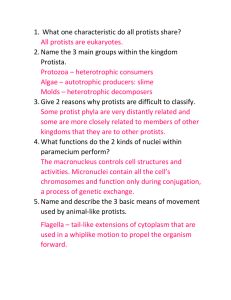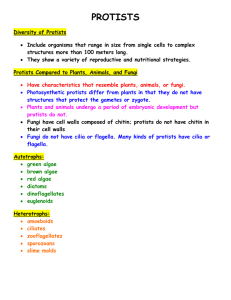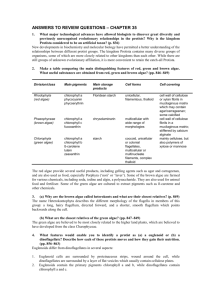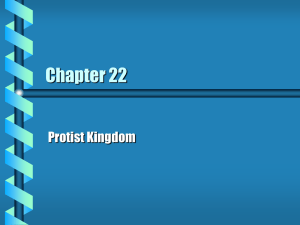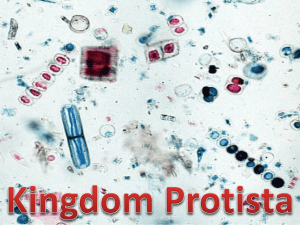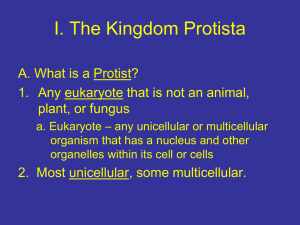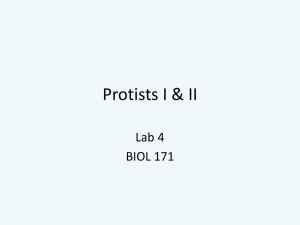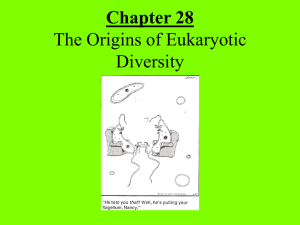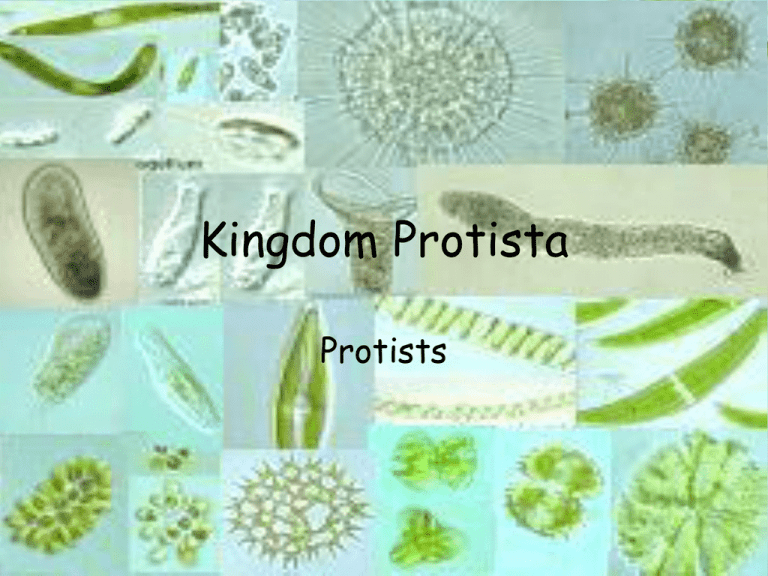
Kingdom Protista
Protists
Diversity of Protists
• Organisms that range in size from
single cells to complex structures
more than 100 meters long.
• They show a variety of reproductive
and nutritional strategies.
Protists Compared to Plants,
Animals, and Fungi
• Characteristics resemble plants, animals, or fungi.
• Photosynthetic protists differ from plants in that they do
not have structures that protect the gametes or zygote.
• Plants and animals undergo a period of embryonic
development but protists do not.
• Fungi have cell walls composed of chitin; protists do not
have chitin in their cell walls
• Fungi do not have cilia or flagella. Many kinds of protists
have cilia or flagella.
Trophic Levels
·
·
·
·
·
·
Autotrophs:
green algae
brown algae
red algae
diatoms
dinoflagellates
euglenoids
·
·
·
·
·
Heterotrophs:
amoeboids
ciliates
zooflagellates
sporozoans
slime molds
Algae
The word algae refers to aquatic (freshwater or marine)
protists.
·
Algae photosynthesize like plants. They produce much
of the oxygen in the atmosphere.
· Algae provide food for aquatic food chains.
Green Algae
Single-celled and multicellular forms.
·
Ancestors of the first plants, both have the following
characteristics in common:
They have a cell wall that contains cellulose.
They have chlorophyll
They store their food as starch inside the chloroplast.
Volvox
· Colonial green algae
· They divide asexually to
produce a daughter colony.
Notice the daughter colonies
within the larger colonies.
Volvox
• Some cells are specialized to produce sperm
and eggs for sexual reproduction which is a
characteristic of multicellular organisms.
• Considered to be a colony because it appears
to be intermediate between a group of
individual cells and a multicellular organism.
Spirogyra
· Filamentous form of green algae.
· Has a ribbonlike spiral-shaped chloroplast.
· Sexual reproduction occurs by conjugation.
·
The zygote is resistant and overwinters.
Spirogyra
Conjugation
Ulva
• Multicellular with a leaf-like body that is
two cells thick but up to one meter long
• Common name: Sea lettuce
Brown Algae
Photosynthetic & multicellular
· Range in size. Many are 50-100 m long.
· Found along rocky shores
The body contains:
· Holdfasts for attachment
· Blades and air bladders that function in floatation
· A stem-like structure that holds the blades is called a
stipe.
Fucus
Common "seaweed" found along the rocky coast.
Brown Algae
Brown Algae - Macrocystis and
Nereocystis (Deep water Kelp)
Nereocystis
Macrocystis
Sargassam
• Sargassam
sometimes breaks
off to form
floating masses.
•
Other marine
organisms
congregate around
these masses.
Red Algae
• Red algae are found mainly in warmer, tropical oceans.
• Accessory photosynthetic pigments are called
phycobilins which allow some species to survive in deep
waters where blue and green light predominates.
• Some species are filamentous but most have a complex
pattern of branching.
• Some coralline forms deposit calcium carbonate in
their cell walls, making coral reefs.
Diatoms
·
Most numerous unicellular algae in the oceans
and are an important source of food and
oxygen.
·
Also important in freshwater environments.
·
The cell walls of diatoms contain silica (a
component of glass).
·
Their remains form diatomaceous earth.
·
Used for pool filtering agents, and abrasives
Diatoms
Dinoflagellates
Protective cellulose plates cover dinoflagellates
Two flagella enable them to move.
They are important in aquatic food chains.
Some species are responsible for red tides that kill fish
and shellfish
Dinoflagellates
Euglenoids
Only one third of the species of Euglenoids are
photosynthetic.
·
·
Euglena use flagella for moving.
An eyespot with a photoreceptor is capable of
detecting the presence of light.
·
Reproduction is asexual.
Euglenoids
Protozoans
· Do not have a cell wall
· Heterotrophic
· Usually motile
· Food vacuoles
· Contractile vacuole (water elimination)
Reproduction is usually asexual but many also reproduce
sexually during some part of their life cycle.
Stentor
Amoeboids
Amoeba
Move by cytoplasmic extensions called pseudopodia.
Feed by phagocytizing (engulfing) their prey.
Most amoeboids are marine organisms;
Amoeba proteus is found in freshwater
Amoeboids
Radiolarians
Marine plankton (float in marine environments) with
a skeleton composed of silica, and numerous needlelike pseudopodia.
Ciliates
• Example - Paramecium
• · The outer covering of paramecium is covered with
hundreds of cilia
• · They have numerous organelles including a gullet (oral
groove) and an anal pore
• · Paramecium has a macronucleus and a micronucleus.
• · The macronucleus controls the cell's activities.
• · The micronucleus is involved in cell reproduction
(sexual & asexual).
• · Sexual reproduction is by conjugation.
Paramecium
Zooflagellates
· Move by flagella
· They may enter into symbiotic
relationships with other organisms.
Trypanosoma - Causes
African Sleeping Sickness
Tsetse fly transmits
Sporozoans
• Parasitic
• Complicated life cycle that usually involves the
formation of infective spores.
e.g. malaria - The parasite is injected into a
human by a mosquito. The parasite then invades
red blood cells and ruptures them.
Protists that are Decomposers
(Saprotrophs)
·
Slime molds play an ecological role similar to that of fungi.
·
They are decomposers, feeding on dead organic material.
·
They differ from fungi in that slime molds ingest their food.
·
·
·
·
Slime molds are masses that creep along the substrate and phagocytize
dead organic material and microorganisms.
The mass is one large cell referred to as a plasmodium.
Spores are resistant to environmental extremes (Food and moisture)
and germinate when environmental conditions become favorable
Saprotrophic; they live off of dead organic matter.
Slime Molds

